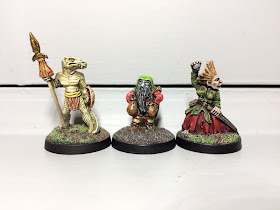 |
| All tomorrow's party ... |
I bought the PDF of The Black Hack's second edition a couple of days ago and am going to be running it tomorrow with some first-time players. It looks terrific.
There are some interesting changes from the first edition of the game, notably with armour. In our first-edition games, armour points (effectively first-line hit points) were a bit of a problem, because they were easily overlooked or forgotten when the dice were flying. The second edition uses a dice pool; you 'burn' a die every time you use an armour point and can then roll them to recover when you have time to rest. That's a big improvement. It also ramps up the effectiveness of armour, shields and helmets, which now stop a blow rather than a point of damage. And it makes a shield highly desirable for an unarmoured fighter, which is just as it should be.
I
don't like the rules for two-handed weapons so much. These too have been revised; it used to be that a two-handed weapon added 2 to the attack and defence rolls (making them harder) and to the damage roll (making it higher). Now they add 1d4. None of this sits well with me: there's nothing about a two-handed weapon that makes it harder to hit with - quite the opposite, in fact. Controlling a spear with two hands is much easier than with one, and the same's true of other pole-arms. And parrying with a two-handed weapon is much easier than with a one-handed one, given the greater control and the ability to slide your hands along the hilt or haft.
Presumably, these rules are an attempt to emulate the sort of ludicrously oversized two-handers you see in fantasy illustrations or the 1982 Conan film. If so, fair enough. But for realistic two-handed weapons, they don't work.
Still, they're easily fixed - and the rules explicitly encourage 'hacking'. The Black Hack uses class-based damage: d4 for wizards, d6 for thieves and clerics and a new special rule for warriors. For now, I'm going to leave the special rule (multiple d6 attacks as an option) and use d8 for warriors and one die higher for two-handed weapons (so, d6 for wizards, d8 for thieves/clerics and d10 for warriors). That should work well: the advantage is modest, and the disadvantage comes from not being able to use a shield - a big old deal, especially if you're unarmoured.
That means that the heavily armoured knight will favour a poleaxe or longsword while the lightly armoured skirmisher will want a shield and a one-handed weapon. I also like the option of allowing players with longswords or spears the ability to switch to two-handed use if (for example) their shield die is 'burnt'. Of course, if you switch to two-handed use during a fight, you've dropped your shield, so if you aren't in a position to pick it up at the conclusion of the battle, you've lost it. You might find a new one on a monster's corpse - which could lead to all sorts of
interesting heraldry-related difficulties ...
I digress. The main thing about the new rules is that they've made the game even more simple and useable. And the streamlining of the rules is just one aspect of this. The bulk of the new book is taken up with random-generation tables that look tremendously useful.
There are tables for wizard names, for the characteristics and cures of diseases, poisons and drugs, for incidents that incite adventures, and for NPC concepts and adventures. There are settlement generators, hex-map generators and tavern generators. There's a dungeon generator, of course, and monster generators, and a richly flavoured bestiary.
All of this stuff is richly flavoured, quirky and often funny - but not as straight-up comic as the League of Gentlemen-ish Sorrowset adventure that accompanied the first edition. In particular, I love the tables for what the various monsters in the bestiary might be up to when encountered - whether it's a wizard arguing with his shadow or a demon taunting a soul trapped in a bottle. And there's plenty of material to answer one immortal question: "What has it got in its pockets?".
This terrific stuff makes up the bulk of the book - and makes it very easy to generate adventures on the fly. Any D&Dish game would benefit from this, regardless of whether Black Hack rules are used or not. I'll pick up the hardback at some point, as this stuff simply screams to be physically bookmarked.
There are also some nice new elements. I think you can see the influence of Whitehack in the way
that character backgrounds can now influence game mechanics. And there are panic rules for PCs, which are great. I bought Torchbearer earlier this year, intrigued by its focus on resource-management in dungeon crawling. But I can't imagine I'll ever use it. The Black Hack does all that stuff much more simply.
Whitehack is likely to remain my favourite D&D ruleset for campaigns, given its elegance and greater sophistication (fighting prowess in The Black Hack is largely down to how strong your character is, for example), but the new edition confirms the The Black Hack as
the go-to for one-shots. And I imagine I'll be using the tables from The Black Hack an awful lot in our ongoing Whitehack campaign.
The new book costs about a fiver in PDF (US$6). If you run fantasy RPGs, I can't imagine why you wouldn't want it.







































